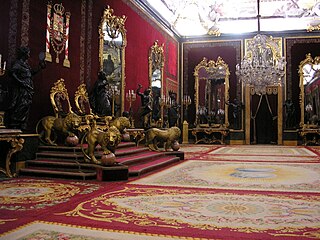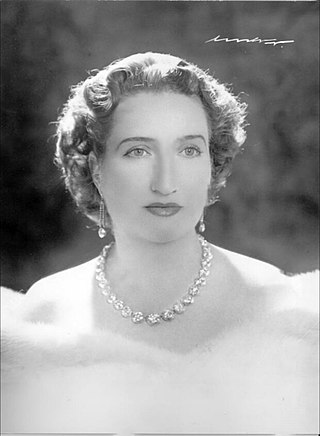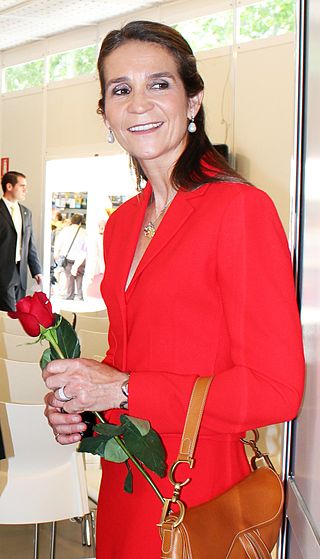
Infanta Cristina is the younger daughter of King Juan Carlos I and his wife, Queen Sofía. She is sixth in the line of succession to the Spanish throne, after her brother King Felipe VI's children, her sister Infanta Elena, Duchess of Lugo, and Elena's children.

Infante Juan, Count of Barcelona, was a claimant to the Spanish throne as Juan III. He was the third son and designated heir of King Alfonso XIII of Spain and Queen Victoria Eugenie of Battenberg. His father was replaced by the Second Spanish Republic in 1931. Juan's son Juan Carlos I became king when Spain's constitutional monarchy was restored in 1975.

The Spanish nobility are people who possess a title of nobility confirmed by the Spanish Ministry of the Presidency, Justice and Relations with the Cortes, as well as those individuals appointed to one of Spain's three highest orders of knighthood, the Order of the Golden Fleece, Order of Charles III and Order of Isabella the Catholic. Some member of the Spanish nobility possess various titles that may be inherited or not, but the creation and recognition of titles is legally the prerogative of the monarchy of Spain.

Infanta Pilar of Spain, Duchess of Badajoz and Viscountess of La Torre, sometimes known more simply as Pilar de Borbón, was the elder daughter of Infante Juan, Count of Barcelona and Princess María Mercedes of the Two Sicilies, and older sister of King Juan Carlos I.

Succession to the Spanish throne follows male-preference cognatic primogeniture. A dynast who marries against the express prohibition of the monarch and the Cortes Generales, the legislative chamber of Spain, is excluded from the succession. Upon proclamation by the Cortes Generales, the monarch is to take an oath to discharge his duties faithfully, to abide by the Constitution and the law and ensure they are abided by, and to respect the rights of the citizens and of the Autonomous Communities.
Infante, also anglicised as "infant" or translated as "prince", is the title and rank given in the Iberian kingdoms of Spain and Portugal to the sons and daughters (infantas) of the king, regardless of age, sometimes with the exception of the heir apparent or heir presumptive to the throne who usually bears a unique princely or ducal title. A woman married to a male infante was accorded the title of infanta if the marriage was dynastically approved, although since 1987 this is no longer automatically the case in Spain. Husbands of born infantas did not obtain the title of infante through marriage, although they were occasionally elevated to the title de gracia at the sovereign's command.

Infanta Margarita of Spain, Duchess of Soria, 2nd Duchess of Hernani, Grandee of Spain, is the younger sister of King Juan Carlos and aunt of the reigning King Felipe VI of Spain.
The Spanish royal family, a branch of the House of Bourbon, is headed by King Felipe VI, and currently consists of Queen Letizia, their children Leonor, Princess of Asturias and Infanta Sofía of Spain, and Felipe's parents, King Juan Carlos I and Queen Sofía. The royal family lives at the Zarzuela Palace in Madrid, although their official residence is the Royal Palace of Madrid. The membership of the royal family is defined by royal decree and consists of: the King of Spain, the monarch's spouse, the monarch's parents, his children, and the heir to the Spanish throne.

María del Rosario Cayetana Fitz-James Stuart y Silva, 18th Duchess of Alba GE was one of the most senior aristocrats in Spain, as well as the most titled aristocrat in the world, a record now held by Princess Victoria of Hohenlohe-Langenburg, 20th Duchess of Medinaceli.

DomSebastian Gabriel de Borbón y Braganza, Infante of Portugal and Spain, was an Iberian prince of the 19th century, progenitor of the Spanish ducal lines of Hernani, Ansola, Dúrcal and Marchena, and Carlist army commander in the First Carlist War.
The Spanish order of precedence is currently prescribed by Royal Decree 2099/1983. The decree establishes the order of precedence of national official activities as well as common regulations to activities organised by municipalities, autonomous communities and other public institutions. The general order established by the decree is modified if the event takes place in the capital, Madrid, instead of elsewhere in Spain.

Don Carlos María Alfonso Marcelo de Borbón-Dos Sicilias y Borbón-Parma, Infante of Spain, Duke of Calabria was, at his death, the last male infante of Spain during the reigns of his cousins King Juan Carlos I and King Felipe VI.

Princess María de las Mercedes of Bourbon-Two Sicilies was a member of the Spanish royal family and the mother of King Juan Carlos I.

Princess Alicia of Bourbon-Parma was a Spanish infanta. A member of the House of Bourbon-Parma, she became Duchess of Calabria through her marriage to Infante Alfonso, Duke of Calabria. She occasionally undertook official duties on behalf of the Spanish monarchy. Through marriage, she was the maternal half-aunt of King Juan Carlos I of Spain. She was the longest-lived Infanta of Spain.

Infanta Elena, Duchess of Lugo, is the first child and eldest daughter of King Juan Carlos I and Queen Sofía. As the eldest sister of King Felipe VI, Elena is the third in the line of succession to the Spanish throne. She has another younger sister, Infanta Cristina.

The Royal Order of Noble Ladies of Queen Maria Luisa is an Order created by King Charles IV of Spain by royal decree on April 21, 1792, at the request of his wife, Queen Maria Luisa, to reward noble women who distinguished themselves for their services and talents. As such, it was established as an honour reserved only for women.
Duke of Hernani is a Spanish noble title. It was created on 11 August 1914 by King Alfonso XIII of Spain and conferred upon his fourth cousin, Manfredo Luis de Borbón, 3rd Duke of Ansola, 2nd Marquis of Antarfe (1889–1979). They are both King Carlos III of Spain's great-great-great grandsons.

Infante of Spain is a royal title normally granted at birth to the children of reigning and past Spanish monarchs, and to the children of the heir to the Crown. Individuals holding the title of infante also enjoy the style of Royal Highness.

The wedding of Infanta Elena of Spain and Don Jaime de Marichalar y Sáenz de Tejada, Lord of Tejada, took place on Saturday, 18 March 1995 at Seville Cathedral in Seville, Andalusia.

DonLuis Gómez-Acebo y Duque de Estrada, Duke of Badajoz, 2nd Viscount of La Torre,, was a Spanish aristocrat and businessman. He was the husband of Infanta Pilar, sister of King Juan Carlos.

















